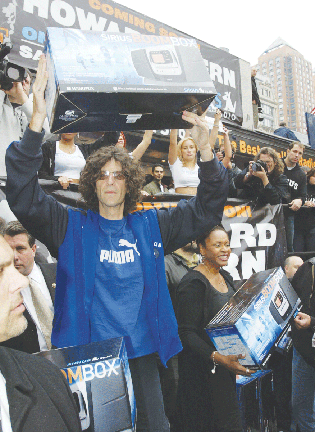Good Artist Borrow – Cerith Wyn Evans Steals
October 14, 2004
It’s tough being an artist these days. Everyone’s so willing to “suffer” for their art now, what with people like Keith Boadwee giving himself paint enemas and David Blain locking himself in a glass box for 40 days (or was that supposed to be magic?). What ever happened to the good old days of scribbling someone else’s name on a prefabricated urinal (Marcel Duchamp’s Fountain 1917) and having every one talk about how profound it is. Well there’s something to be said about conceptual “firsts” but I’ll save that for a little later.
Now showing at the MFA, filmmaker and conceptual artist Cerith Wyn Evans will be exhibiting a portion of his work through January 30, 2005. It should not be too difficult to find his exhibit in the dark dank halls of the MFA’s special-exhibition Foster Gallery which has a focus on contemporary art (or what I like to call modern, with a lower case “m”- thanks, Derek Mengus).
His first installation is a piece entitled Chandeliers 2004, which features a series of the eponymous chandeliers, each from a different time period, programmed to alternately flash on and off, which is what makes his exhibit noticeable even while standing in another gallery. In the context of a museum, this at least makes it immediately interesting. Evans explains that it reflects his interest in communication and the piece was influenced by a visit to a Tokyo where from his hotel room all the lights of the city’s skyline flashed in a seeming form of speech. Wyn Evans’ Chandeliers instead flashed excerpts in Morse code that were thankfully displayed on computer monitors in English, as I am otherwise unable to speak flashing chandelier language.
The second room was by far the most remarkable in this exhibit. It contained a collection of some truly amazing photography. However, for the sake of Cerith Wyn Evans maybe I shouldn’t describe them. All black and white, the photos seem to have several themes to their composition, namely: a series of close-ups of wood formations, studio shots, and natural setting scenes. All professional quality photography, they seemed to share a certain suburban post-war American aesthetic that, because of subtle details in the subject matter and composition, seemed to exaggerate this quality giving an apparent sense of self-awareness that caused them to feel vaguely surreal. The series of wood formations, close-ups of roots and stumps, seemed physically unaltered but resembled human faces and figures. The studio shots varied from contrived arrangements that included photos of rather banal subjects such as cat, a priest, and a woman with beehive hair. Lit using a three-point lighting system and printed with superior clarity, the photos retained a strong sense of formality but at the same time their subtly skewed composition made them seem almost a parody of their own period specific conventions. The series of candid life photos were more straight forward but one featured young children playing outside – the girls wearing Sunday dresses, a boy with a cowboy hat, and a dog – which seemed to acknowledge and embrace its own clichéd subject matter.
But it is not entirely correct to judge the photos on this level. The unlabeled individual photographs were instead explained as a single body of work, Photographs, 2004. This is because they themselves are not the product of Cerith Wyn Evans himself, but instead were the work of his father, Sul Wyn Evans, that the “artist” “borrowed.” So Cerith has made a convenient use of ready-mades; re-appropriating them to achieve a broader concept. His actual concept may be a bit difficult to grasp, if at all appreciate, since it must solely involve the selection and arrangement of objects. The photos are lined single file across the room at eye-level. The concept seems to be equal to that of a museum curator – perhaps the long lost art form? Any conceptual achievement on Cerith’s part will be lost in the simple fact that his fathers photos are really good. It’s inevitable that the two works will be compared – Sul Wyn Evans’ rich and captivating photography against his son’s conceptual work, which at best, amounts to thinly veiled plagiarism. The difference between this and Marcel Duchamp’s Fountain, is that Duchamp’s concept is greater than the possible aesthetics of the physical work, a urinal. Whereas Cerith Wyn Evans’ Photographs seems to suffer from the opposite effect.
In the end it was Cerith Wyn Evans biography that showed the most promise for the artist. He had previous experience doing experimental film and directed videos for bands such as The Smiths, Throbbing Gristle, and The Fall. He also has a complementary exhibition showing at MIT’s List Visual Arts Center in Cambridge through December 31.






















































